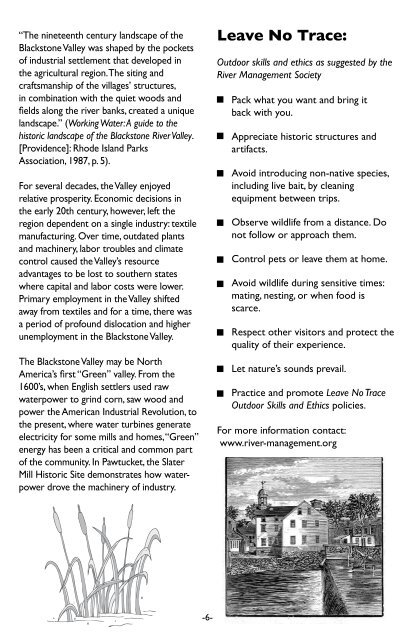The Green Visitor Guide - Blackstone Valley Tourism Council
The Green Visitor Guide - Blackstone Valley Tourism Council
The Green Visitor Guide - Blackstone Valley Tourism Council
You also want an ePaper? Increase the reach of your titles
YUMPU automatically turns print PDFs into web optimized ePapers that Google loves.
“<strong>The</strong> nineteenth century landscape of the<br />
<strong>Blackstone</strong> <strong>Valley</strong> was shaped by the pockets<br />
of industrial settlement that developed in<br />
the agricultural region. <strong>The</strong> siting and<br />
craftsmanship of the villages’ structures,<br />
in combination with the quiet woods and<br />
fields along the river banks, created a unique<br />
landscape.” (Working Water: A guide to the<br />
historic landscape of the <strong>Blackstone</strong> River <strong>Valley</strong>.<br />
[Providence]: Rhode Island Parks<br />
Association, 1987, p. 5).<br />
For several decades, the <strong>Valley</strong> enjoyed<br />
relative prosperity. Economic decisions in<br />
the early 20th century, however, left the<br />
region dependent on a single industry: textile<br />
manufacturing. Over time, outdated plants<br />
and machinery, labor troubles and climate<br />
control caused the <strong>Valley</strong>’s resource<br />
advantages to be lost to southern states<br />
where capital and labor costs were lower.<br />
Primary employment in the <strong>Valley</strong> shifted<br />
away from textiles and for a time, there was<br />
a period of profound dislocation and higher<br />
unemployment in the <strong>Blackstone</strong> <strong>Valley</strong>.<br />
<strong>The</strong> <strong>Blackstone</strong> <strong>Valley</strong> may be North<br />
America’s first “<strong>Green</strong>” valley. From the<br />
1600’s, when English settlers used raw<br />
waterpower to grind corn, saw wood and<br />
power the American Industrial Revolution, to<br />
the present, where water turbines generate<br />
electricity for some mills and homes, “<strong>Green</strong>”<br />
energy has been a critical and common part<br />
of the community. In Pawtucket, the Slater<br />
Mill Historic Site demonstrates how waterpower<br />
drove the machinery of industry.<br />
-6-<br />
Leave No Trace:<br />
Outdoor skills and ethics as suggested by the<br />
River Management Society<br />
Pack what you want and bring it<br />
back with you.<br />
Appreciate historic structures and<br />
artifacts.<br />
Avoid introducing non-native species,<br />
including live bait, by cleaning<br />
equipment between trips.<br />
Observe wildlife from a distance. Do<br />
not follow or approach them.<br />
Control pets or leave them at home.<br />
Avoid wildlife during sensitive times:<br />
mating, nesting, or when food is<br />
scarce.<br />
Respect other visitors and protect the<br />
quality of their experience.<br />
Let nature’s sounds prevail.<br />
Practice and promote Leave No Trace<br />
Outdoor Skills and Ethics policies.<br />
For more information contact:<br />
www.river-management.org



